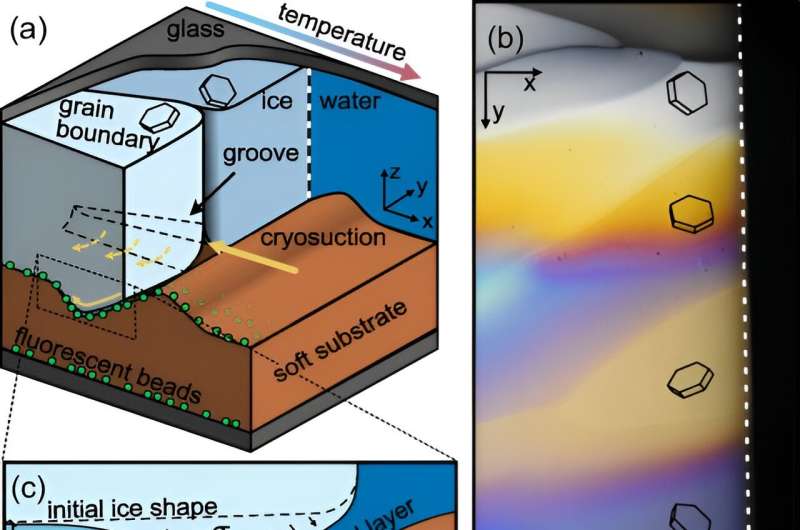November 27, 2023 report
This article has been reviewed according to Science X's editorial process and policies. Editors have highlighted the following attributes while ensuring the content's credibility:
fact-checked
peer-reviewed publication
trusted source
proofread
Experiment shows how water-filled channels crisscrossing multi-crystal ice lead to fractures

A combined team of materials scientists and engineers from the Swiss Federal Institute of Technology and Yale University, has shown via lab experiment, how water-filled channels crisscrossing multi-crystal ice can lead to fractures in materials such as cement and asphalt. In their paper published in the journal Physical Review Letters, the group describes the experiments they conducted with transparent objects, water and silicone, to show how liquid channels in ice can lead to fractures in porous materials.
Water, unlike other liquids, expands when it freezes. This is due to the unique shape of water molecules and the angles that form between them when water freezes. Such expansion is often blamed for damage done to materials such as roads and driveways but as the researchers point out, such damage is due to ice crystal growth, not the expansion of water. So the team investigated crystal growth to determine how it causes damage.
Noting that in the real world most such damage occurs in opaque materials, such as concrete and asphalt, which makes it very difficult to study the process as it happens, the researchers took another approach. They created an environment where all the materials would behave the same way but were also transparent.
The team started with two glass slides separated by spacers. They then made a single tiny pore using a light-curable glue—just millimeters long and wide. Next, they covered the inside of the bottom side of the pore with a thin coat of silicone, which they speckled with fluorescent particles before allowing it to harden. Then they filled the pore with water.
With their apparatus built, they then chilled just one end of the pore they had made while heating the other end. And then they watched the action using a microscope. They found that as the water in the chilled end froze, the silicone started to deform and as it did so, the ice crystal that had formed in the pore grew bigger around and as it did so, it exerted pressure on the silicone layer.
A closer look at the silicone layer showed that a film of water persisted between the ice and the silicone, serving as the source of new water for continued expansion, which led to the type of damage seen in materials such as cement and asphalt.
More information: Dominic Gerber et al, Polycrystallinity Enhances Stress Buildup around Ice, Physical Review Letters (2023). DOI: 10.1103/PhysRevLett.131.208201
Journal information: Physical Review Letters
© 2023 Science X Network





















